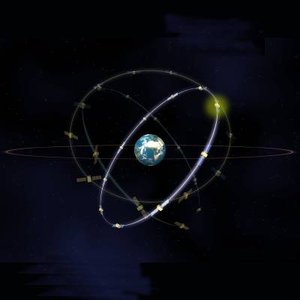Galileo and EGNOS
Europe's Galileo satellite navigation system – currently under construction – will provide high-quality positioning, navigation and timing services to users across the whole world.
A civil-controlled system offering guaranteed continuity of coverage, Galileo is the outcome of a partnership between ESA and the European Commission.
Galileo’s full operational constellation will consist of 24 operational satellites plus six spares circling Earth in three circular medium-Earth orbits, at an altitude of 23222 km. Galileo will be interoperable with the US GPS and Russian Glonass systems, offering enhanced combined performance.
Building on the success of EGNOS

The first pillar of Europe's navigation programme, the European Geostationary Navigation Overlay Service (EGNOS) – operational since 2009 – is an overlay system based on a network of ground stations and three geostationary satellites.
The stations gather data on the current accuracy of GPS signals and embed it in the EGNOS signal, which is uplinked to the satellites to be transmitted to users.
EGNOS serves to sharpen the accuracy of GPS signals across Europe and informing users about the current reliability level of the system.
Designed against global standards set by the International Civil Aviation Organisation (ICAO), EGNOS began offering its Open Service for non-safety-of-life uses in October 2009, with its Safety-of-Life Service becoming available for aircraft navigation (allowing vertical guidance for landing approaches) from March 2011.
Services on offer

Galileo Initial services have already begun, based on the current constellation in orbit:
- Open Service The Galileo navigational signal is accessible to the general public free of charge, providing improved global positioning.
- Search and Rescue Service Galileo is contributing to the international Cospas–Sarsat system for search and rescue.
Further services will be available when the constellation is complete:
- Public Regulated Service Two encrypted signals with controlled access for specific users such as governmental bodies.
- Safety-of-Life Service Already available for aviation to the ICAO standard thanks to EGNOS. The system will be extended to augment Galileo as well, thus further improving service performance.
- Commercial Service Galileo will provide a signal for high data throughput and highly accurate authenticated data, particularly interesting for professional users.















 Germany
Germany
 Austria
Austria
 Belgium
Belgium
 Denmark
Denmark
 Spain
Spain
 Estonia
Estonia
 Finland
Finland
 France
France
 Greece
Greece
 Hungary
Hungary
 Ireland
Ireland
 Italy
Italy
 Luxembourg
Luxembourg
 Norway
Norway
 The Netherlands
The Netherlands
 Poland
Poland
 Portugal
Portugal
 Czechia
Czechia
 Romania
Romania
 United Kingdom
United Kingdom
 Slovenia
Slovenia
 Sweden
Sweden
 Switzerland
Switzerland




































